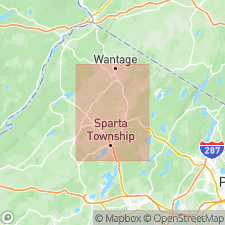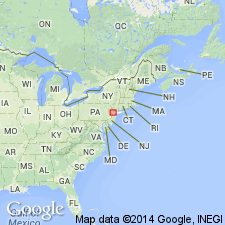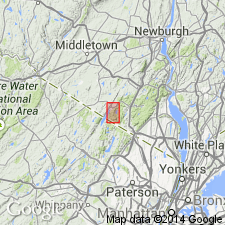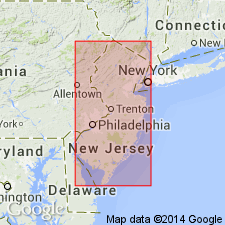
- Usage in publication:
-
- Byram granite gneiss*
- Modifications:
-
- Named
- Dominant lithology:
-
- Granite
- Gneiss
- AAPG geologic province:
-
- Appalachian basin
Summary:
The rocks here grouped as Byram gneiss include several varieties of granitoid gneiss which are lithologically related by presence of potash-bearing feldspars among their principal mineral components. Composed essentially of quartz, and microcline or microperthite (potash feldspars), with variable proportions of hornblende, pyroxene, and mica. Oligoclase (soda-lime feldspar) usually very subordinate in amount, but here and there it equals the potash feldspar. Accessory minerals are magnetite, zircon, apatite, and titanite. There are several facies of the rock that vary greatly in appearance in the field, but almost without exception show greater resemblance to each other than to varieties of other gneisses with which they are associated. In a broad way the Byram gneiss can be separated into light and dark facies. General tone of dark facies is ordinarily gray in outcrop, but on fresh surfaces brownish accompanied by bronzy effect. A common dark variety contains considerable hornblende in crystals grouped in form of pencils arranged parallel to a common axis. The light varieties are yellowish in outcrop, and pink, light gray, or whitish on fresh surfaces. Usually they are somewhat finer grained and less foliated than the dark facies and carry mica rather than hornblende or pyroxene. The Byram gneiss includes "Hamburg" [Mountain] gneiss, "Sand Pond," and "Edison" gneisses of Wolff, the "Oxford type" of Nason, and gneissoid granite of Breakneck Mountain, on the Hudson. Appears to cut Pochuck gneiss and Franklin limestone. Relations to Losee gneiss not known.
Source: US geologic names lexicon (USGS Bull. 896, p. 307-308).

- Usage in publication:
-
- Byram granite gneiss*
- Modifications:
-
- Overview
- AAPG geologic province:
-
- Appalachian basin
Summary:
The Byram gneiss (predominantly granite gneiss) is now [ca. 1938] considered as probably younger than Losee gneiss (predominantly diorite). It is classified by E.B. Knopf and A.I. Jonas (USGS Bull. 799, correlation chart, 1929) as post-Glenarm. Intrudes Franklin limestone and Pickering gneiss.
Source: US geologic names lexicon (USGS Bull. 896, p. 307-308).

- Usage in publication:
-
- Byram Intrusive Suite*
- Modifications:
-
- Overview
- AAPG geologic province:
-
- Appalachian basin
Summary:
Rocks called Type III Byram gneiss by Hague and others (1956), are here named Lake Hopatcong Intrusive Suite. Newly named unit occurs throughout the NJ Highlands in large sheets emplaced in the Grenville Orogeny similar to quartz syenites in the Adirondacks in NY. Relation to the Byram Intrusive Suite is not known. They differ in chemistry, mineralogy, and petrography, and are clearly two entities.
Source: GNU records (USGS DDS-6; Reston GNULEX).

- Usage in publication:
-
- Byram Intrusive Suite*
- Modifications:
-
- Areal extent
- Geochronologic dating
- AAPG geologic province:
-
- Appalachian basin
Summary:
Extended into NY through mapping in the Greenwood Lake quad, NY. Time of emplacement interpreted as 1090 Ma by U-Pb methods on seven fractions.
Source: GNU records (USGS DDS-6; Reston GNULEX).

- Usage in publication:
-
- Byram Intrusive Suite
- Modifications:
-
- Areal extent
- Overview
- AAPG geologic province:
-
- Appalachian basin
Summary:
Rocks of the Byram Intrusive Suite are fairly evenly distributed throughout the Highlands, but are probably most abundant in the Greenwood Lake, Newfoundland, Dover, Mendham, Bernardsville, Gladstone, Califon, Stanhope, Tranquility, and Washington quads. Unit is variable in texture and ranges from gneissoid granite and lesser granite gneiss to indistinctly foliated granite and pegmatite. Consists predominantly of hornblende granite, biotite granite, microperthite alaskite, hornblende quartz syenite, and hornblende syenite. Byram rocks are characteristically pinkish-gray and medium to coarse-grained. Hornblende and biotite are the dominant mafic minerals. Magnetite is ubiquitous in all phases. U-Pb data from zircons in Greenwood Lake quad yields age range of 1122+/-53 Ma to 1088+/-41 Ma (Drake and others, 1991). Recent geochemical work suggests that the Byram and Hopatcong Suites do not actually define two distinct and separate intrusive suites as originally suggested. Author interprets the Byram and Lake Hopatcong rocks to be cogenetic and comagmatic. Principal differences between them are in the mineralogy and the slightly more evolved composition of the Byram. The Lake Hopatcong rocks formed under relatively anhydrous conditions, which favored development of clinopyroxene and suppressed the formation of pegmatites, more common in the Byram.
Source: GNU records (USGS DDS-6; Reston GNULEX).

- Usage in publication:
-
- Byram Intrusive Suite*
- Modifications:
-
- Revised
- AAPG geologic province:
-
- Appalachian basin
Summary:
Middle Proterozoic Byram Intrusive Suite and Lake Hopatcong Intrusive Suite assigned to Vernon Supersuite (new), named for Vernon Township, Sussex Co., northern NJ. Byram consists of hornblende granite, microperthite alaskite, hornblende quartz syenite, syenite, hornblende granite, hornblende monzonite, and quartz monzonite. Lake Hopatcong rocks include granite, quartz monzonite, monzonite, granodiorite, and quartz monzogranodiorite. Byram and Hopatcong are cogenetic and comagmatic, an interpretation supported by field relationships and geochemical relationships.
Source: GNU records (USGS DDS-6; Reston GNULEX).
For more information, please contact Nancy Stamm, Geologic Names Committee Secretary.
Asterisk (*) indicates published by U.S. Geological Survey authors.
"No current usage" (†) implies that a name has been abandoned or has fallen into disuse. Former usage and, if known, replacement name given in parentheses ( ).
Slash (/) indicates name conflicts with nomenclatural guidelines (CSN, 1933; ACSN, 1961, 1970; NACSN, 1983, 2005, 2021). May be explained within brackets ([ ]).

